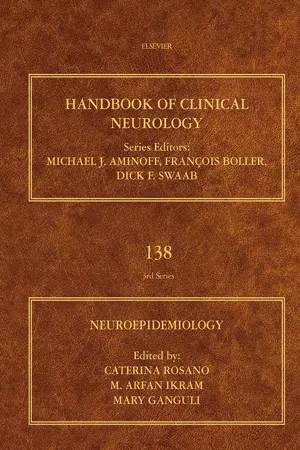
- 352 pages
- English
- ePUB (mobile friendly)
- Available on iOS & Android
About This Book
Neuroepidemiology covers the foundations of neuroepidemiological research and the epidemiology of disorders primarily affecting the nervous system, as well as those originating outside the nervous system. The etiology of many important central nervous system disorders remains elusive. Even with diseases where the key risk determinants have been identified, better prevention and therapy is needed to reduce high incidence and mortality. Although evolving technologies for studying disease provide opportunities for such, it is essential for researchers and clinicians to understand how best to apply such technology in the context of carefully characterized patient populations.
By paying special attention to methodological approaches, this volume prepares new investigators from a variety of disciplines to conduct epidemiological studies in order to discern the etiologic factors and underlying mechanisms that influence the onset, progression, and recurrence of CNS disorders and diseases. The book also provides current information on methodological approaches for clinical neurologists seeking to expand their knowledge in research.
- Includes coverage of the foundations of neuroepidemiological research and the epidemiology of disorders primarily affecting the nervous system, as well as those originating outside the nervous system
- Describes the most recent methodologies to define and quantify the burden of CNS disorders and to understand the underlying mechanisms, with neuroimaging and molecular methods receiving particular emphasis
- Offers extensive description of those neurological conditions that are secondary to other diseases whose incidence is on the rise because of longer survival rates
- Features chapters authored by leaders in the field from around the globe
Frequently asked questions
Information
Epidemiology for the clinical neurologist
2 Departments of Psychiatry, Neurology, and Epidemiology, University of Pittsburgh, Pittsburgh, PA, USA
* Correspondence to: Mary Ganguli, MD, MPH, WPIC, 3811 O’Hara Street, Pittsburgh PA 15213, USA. Tel: + 1-412-647-6516 email address: [email protected]
Abstract
Keywords
What is epidemiology?
Uses of epidemiology
| 1. Make a community diagnosis 2. Supplement the clinical picture 3. Identify causal/risk factors 4. Compute individual risk 5. Chart historic trends 6. Delineate new syndromes 7. Evaluate health services |
Making a community diagnosis
Table of contents
- Cover image
- Title page
- Table of Contents
- Copyright
- Handbook of Clinical Neurology 3rd Series
- Foreword
- Preface
- Contributors
- Chapter 1: Epidemiology for the clinical neurologist
- Chapter 2: Population neuroscience
- Chapter 3: Advanced epidemiologic and analytical methods
- Chapter 4: Basics of neuroanatomy and neurophysiology
- Chapter 5: Population imaging in neuroepidemiology
- Chapter 6: Use of “omics” technologies to dissect neurologic disease
- Chapter 7: Neuropsychologic assessment
- Chapter 8: Dementias
- Chapter 9: Epidemiology of alpha-synucleinopathies: from Parkinson disease to dementia with Lewy bodies
- Chapter 10: Epidemiology of epilepsy
- Chapter 11: The epidemiology of multiple sclerosis: insights to a causal cascade
- Chapter 12: Neuroepidemiology of traumatic brain injury
- Chapter 13: The epidemiology of amyotrophic lateral sclerosis
- Chapter 14: Cerebrovascular disease
- Chapter 15: Peripheral neuropathies
- Chapter 16: Migraine
- Chapter 17: Neuroepidemiology of cancer and treatment-related neurocognitive dysfunction in adult-onset cancer patients and survivors
- Chapter 18: Sickle cell disease
- Index
